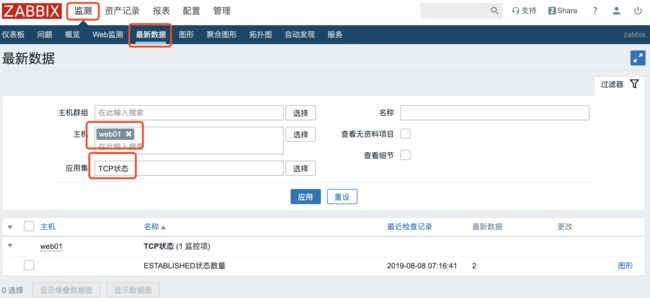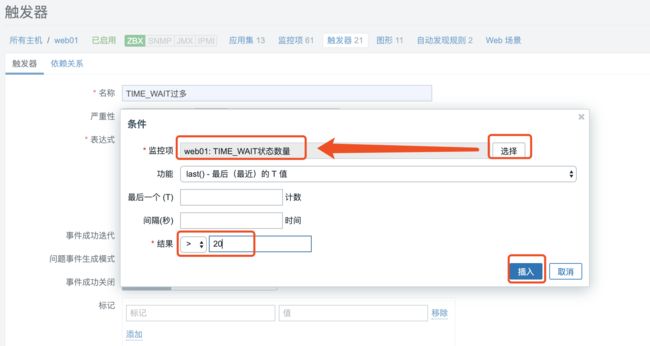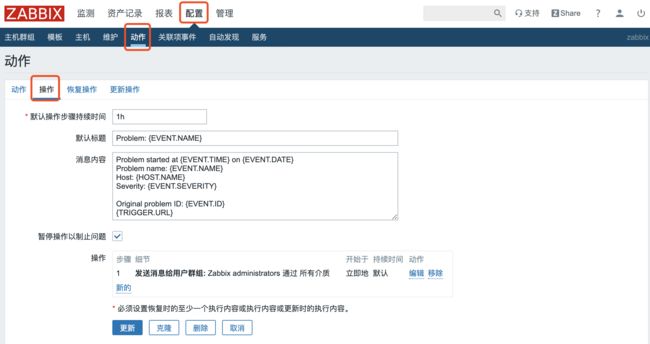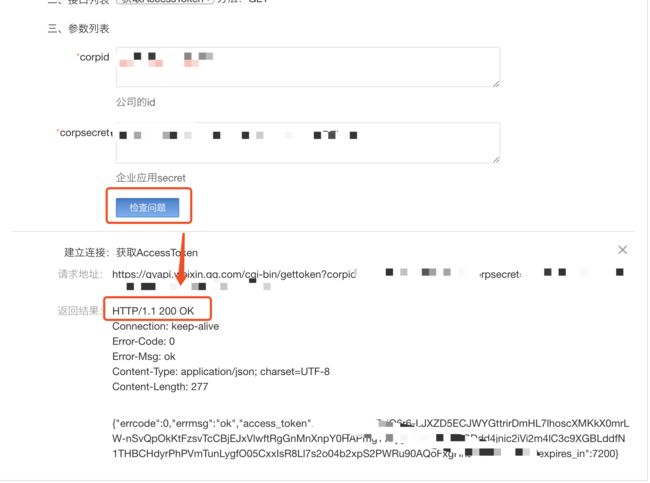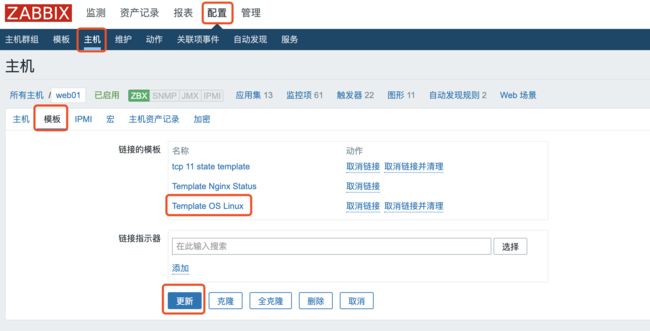zabbix监控详细安装到部署
1.为什么要使用监控 ---运维大多数时候都是监控 只要能取到值,就能监控到
1)对系统不间断实时监控
2)实时反馈系统当前状态
3)保证服务可靠性安全性
4)保证业务持续稳定运行
2.如何进行监控,比如我们需要监控磁盘的使用率
1.如何查看磁盘使用率:
df -h2.监控磁盘的那些指标:
block, inode3.如何获取具体的信息:
df -h|awk '//Tex parse error!(NF-1)}'4.获取的数值到达多少报警:80%
3.流行的监控工具
1)Zabbix
2)Lepus(天兔)数据库监控系统 ---好久不更新了
3)Open-Falcon小米
4)Prometheus(普罗米修斯,Docker,K8s)
4.如果一家新公司,如何入手监控
1.硬件监控 路由器,交换机,防火墙
2.系统监控 CPU,内存,磁盘,网络,进程,TCP (比较重要优先监控)
3.服务监控 nginx,php,tomcat,redis,memcache,mysql
4.WEB监控 请求时间,响应时间,加载时间
5.日志监控 ELk(手机,存储,分析,展示)日志易
6.安全监控 Firewalld,WAF(Nginx+lua),安全宝,牛盾云,安全狗
7.网络监控 smokeping,多机房
8.业务监控 活动引入多少流量,产生多少注册量,带来多大价值
第二章 安装zabbix
rpm -ivh https://mirrors.tuna.tsinghua.edu.cn/zabbix/zabbix/4.0/rhel/7/x86_64/zabbix-release-4.0-1.el7.noarch.rpm安装zabbix所需要的依赖
yum install -y zabbix-server-mysql zabbix-web-mysql zabbix-agent mariadb-server初始化zabbix
systemctl start mariadb.service && systemctl enable mariadb.service这里需要我们提前安装Mysql或者mariaDB,没有安装的可以看我以前的安装方法
创建mysql账号密码:
mysqladmin password 123456登录mysql:
mysql -uroot -p123456登录进去以后开始在数据库中设置我们的zabbix所需要的文件:
create database zabbix character set utf8 collate utf8_bin;grant all privileges on zabbix.* to zabbix@localhost identified by 'zabbix';flush privileges;退出数据库后更新:
mysql_secure_installation重新用zabbix账号登录mysql,检验一下看看是否可以登录,可以的话可以在退出
登录zabbix账号密码:mysql -uzabbix -pzabbix导入zabbix数据到数据库里面
zcat /usr/share/doc/zabbix-server-mysql-4.0.42/create.sql.gz | mysql -uzabbix -pzabbix zabbix导入了很多个表可以用下面命令查看
mysql -uuzabbix -pzabbix use zabbix; show tables;修改zabbix配置文件:vim /etc/zabbix/zabbix_server.conf改下面四条,其实就是配置zabbix登录界面账号密码等信息
DBHost=localhost
DBName=zabbix
DBUser=zabbix
DBPassword=zabbix配置 Apache 的配置文件/etc/httpd/conf.d/zabbix.conf,修改时区
php_value date.timezone Asia/Shanghai重启Apache Web 服务器
systemctl start httpd启动 Zabbix 服务进程,并加入开机自启
systemctl start zabbix-server.service
systemctl enable zabbix-server.service现在开始验证zabbix是否可用
http://192.168.174.137/zabbix/setup.php
#我这里配置使用的Ip地址是137,因人而异检查依赖项是否存在异常
配置zabbix连接数据库
配置 ZabbixServer 服务器的信息
调整字符集为中文
点击finish输入账号Admin密码zabbix
乱码解决方法:用Linux系统下自带的字体进行
[root@m01 ~]# yum install wqy-microhei-fonts -y
[root@m01 ~]# cp /usr/share/fonts/wqy-microhei/wqy-microhei.ttc /usr/share/zabbix/assets/fonts/graphfont.ttf
Zabbix 监控基础架构
zabbix-agent(数据采集)—>zabbix-server(数据分析|报警)—> 数据库(数据存储)<—zabbix web(数据展示)
zabbix 快速监控主机
1.安装zabbix-agent
rpm -ivh https://mirror.tuna.tsinghua.edu.cn/zabbix/zabbix/4.0/rhel/7/x86_64/zabbix-agent-4.0.11-1.el7.x86_64.rpm2.配置zabbix-agent
yum install zabbix-agent -y2.修改zabbix-agent.conf配置文件
进入到vim /etc/zabbix/zabbix_agentd.conf后全部删除输入以下文本
PidFile=/var/run/zabbix/zabbix_agentd.pid
LogFile=/var/log/zabbix/zabbix_agentd.log
LogFileSize=0
Server=192.168.174.137 #两个ip地址是填写服务端的
ServerActive=192.168.174.137
Hostname=138
Include=/etc/zabbix/zabbix_agentd.d/*.conf3.启动zabbix-agent并检查
[root@web01 ~]# systemctl start zabbix-agent.service
[root@web01 ~]# systemctl enable zabbix-agent.service
[root@web01 ~]# netstat -lntup|grep 10050
tcp 0 0 0.0.0.0:10050 0.0.0.0:* LISTEN 10351/zabbix_agentd
tcp6 0 0 :::10050 :::* LISTEN 10351/zabbix_agentd 如果出现错误,可以看日志是否启动成功:tail -f /var/log/zabbix/zabbix_agentd.log
出现了一个1105报错在解析文件里面添加vim /etc/hosts 192.168.174.138 138
[root@web01 ~]# systemctl start zabbix-agent.service
[root@web01 ~]# systemctl enable zabbix-agent.service
[root@web01 ~]# netstat -lntup|grep 10050
4.zabbix-web界面,添加主机
在服务端安装测试命令
yum install zabbix-get.x86_64
测试一下是否可以接通:zabbix_get -s 192.168.174.138 -k agent.hostname
补充监控项 ---你要监控的内容,监控指标,比如有很多项目,项目1,项目2
模板 ---将一类的监控项汇总在一起,单独保存成一个集合,可以直接被其他主机调用
agent ---客户端,需要监控那台主机
key:value ---监控项目名称:将空项目返回的值
应用集合 ---比如说一个CPU可以选择监控多个选项,有CPU的内存,负载有5个监控项,打一个标签,比如CPU里面的所有功能,这样好过滤
触发器 ---设定某个监控项报警的阈值条件
图形 ---监控项的趋势 可以是多个监控项的内容
聚合图形 ---很多个图形放在一起展示
目标:取到访问频次较高的IP,并且报警
思路:
1.如何取到访问频次较高的IP
2.写脚本判断,如果这个IP超过了100次,就zabbix报警
3.zabbix监控这个脚本返回的值 设置触发器,如果超过100次就报警
实现:
1.通过ELK的API指令去获取
2.写脚本去调用ELK的API命令并把值
3.zabbix监控这个脚本返回的值并设置触发器
自定义监控主机小试身手
1.监控需求
监控TCP11种状态集
2.命令行实现
这个是在服务器上的
[root@web01 ~]# netstat -ant|grep -c TIME_WAIT
55
[root@web01 ~]# netstat -ant|grep -c LISTEN
123.编写zabbix监控文件(传参形式)
[root@web01 ~]# cat /etc/zabbix/zabbix_agentd.d/tcp_status.conf
UserParameter=tcp_state[*],netstat -ant|grep -c $1
root@web01 ~]# systemctl restart zabbix-agent.service4.server端进行测试
客户端测试
[root@m01 ~]# rpm -ivh https://mirrors.tuna.tsinghua.edu.cn/zabbix/zabbix/4.0/rhel/7/x86_64/zabbix-release-4.0-1.el7.noarch.rpm
[root@m01 ~]# yum install zabbix-get.x86_64 -y
[root@m01 ~]# zabbix_get -s 10.0.1.7 -k tcp_state[TIME_WAIT]
51
[root@m01 ~]# zabbix_get -s 10.0.1.7 -k tcp_state[LISTEN]
125.web端添加
6.克隆监控项
由于TCP有多种状态,需要添加多个监控项,我们可以使用克隆快速达到创建的效果
其他的状态依次添加即可
7.创建图形
8.查看图形
9.设置触发器
![]()
第八章 邮件报警
1.定义发件人
2.定义收件人
3.自定义报警内容过
定制报警内容:
https://www.zabbix.com/documentation/4.0/zh/manual/appendix/macros/supported_by_location
参考博客
https://www.cnblogs.com/bixiaoyu/p/7302541.html发送警告
报警邮件标题可以使用默认信息,亦可使用如下中文报警内容
名称:Action-Email
默认标题:故障{TRIGGER.STATUS},服务器:{HOSTNAME1}发生: {TRIGGER.NAME}故障!
告警主机:{HOSTNAME1}
告警时间:{EVENT.DATE} {EVENT.TIME}
告警等级:{TRIGGER.SEVERITY}
告警信息: {TRIGGER.NAME}
告警项目:{TRIGGER.KEY1}
问题详情:{ITEM.NAME}:{ITEM.VALUE}
当前状态:{TRIGGER.STATUS}:{ITEM.VALUE1}
事件ID:{EVENT.ID} 恢复警告
恢复标题:恢复{TRIGGER.STATUS}, 服务器:{HOSTNAME1}: {TRIGGER.NAME}已恢复!
恢复信息:
告警主机:{HOSTNAME1}
告警时间:{EVENT.DATE} {EVENT.TIME}
告警等级:{TRIGGER.SEVERITY}
告警信息: {TRIGGER.NAME}
告警项目:{TRIGGER.KEY1}
问题详情:{ITEM.NAME}:{ITEM.VALUE}
当前状态:{TRIGGER.STATUS}:{ITEM.VALUE1}
事件ID:{EVENT.ID}第九章 微信报警
1.查看配置文件里的脚本目录路径
[root@m01 ~]# grep "^AlertScriptsPath" /etc/zabbix/zabbix_server.conf
AlertScriptsPath=/usr/lib/zabbix/alertscripts2.将weixin.py放在zabbix特定目录
[root@m01 /usr/lib/zabbix/alertscripts]# ll
总用量 4
-rwxr-xr-x 1 root root 1344 8月 7 21:58 weixin.py3.配置发信人
4.配置收信人
5.登陆企业微信公众号添加账户
https://work.weixin.qq.com/wework_admin/loginpage_wx
1.登陆后在企业号上新建应用
3.查看启动应用
同时会生成应用的AgentId以及Secret,这个在后面步骤会有用
4.接口调用测试
http://work.weixin.qq.com/api/devtools/devtool.php
这里的corpid为公司ID
Corpsecret就是刚才创建应用生成的Secrt,确认没问题填写进去然后下一步
如果没问题会显示200状态码
6.添加成员
7.关注公众号
8.查看自己的账号
9.修改脚本里的信息
[root@m01 /usr/lib/zabbix/alertscripts]# cat weixin.py
..............
corpid='微信企业号corpid'
appsecret='应用的Secret'
agentid=应用的id
..............10.发信测试
[root@m01 /usr/lib/zabbix/alertscripts]# python weixin.py 你的账号 '发信测试' ‘微信测试消息’11.微信号上查看
12.发送到整个微信组
虽然我们实现了发送到单个用户的功能,但是如果我们的用户比较多,这样还是麻烦的,不过我们可以发送到整个组,其实脚本里已经预留好了配置,只不过默认注释了。
将脚本修改为以下内容,注释掉用户,打开组设置12.随机发送到指定用户玩笑脚本
#!/usr/bin/env python
import requests
import sys
import os
import json
import logging
logging.basicConfig(level = logging.DEBUG, format = '%(asctime)s, %(filename)s, %(levelname)s, %(message)s',
datefmt = '%a, %d %b %Y %H:%M:%S',
filename = os.path.join('/tmp','weixin.log'),
filemode = 'a')
corpid='wwd26fdfb9940e7efa'
appsecret='Btg89FnZfMu0k7l6b4iagmAR5Z9TCgKknYbx-SMQvmg'
agentid=1000005
token_url='https://qyapi.weixin.qq.com/cgi-bin/gettoken?corpid=' + corpid + '&corpsecret=' + appsecret
req=requests.get(token_url)
accesstoken=req.json()['access_token']
msgsend_url='https://qyapi.weixin.qq.com/cgi-bin/message/send?access_token=' + accesstoken
#touser=sys.argv[1]
toparty=sys.argv[1]
subject=sys.argv[2]
message=sys.argv[2] + "\n\n" +sys.argv[3]
params={
#"touser": touser,
"toparty": toparty,
"msgtype": "text",
"agentid": agentid,
"text": {
"content": message
},
"safe":0
}
req=requests.post(msgsend_url, data=json.dumps(params))
logging.info('sendto:' + toparty + ';;subject:' + subject + ';;message:' + message) 12.随机发送到指定用户玩笑脚本
#!/bin/bash
num=$(echo $(($RANDOM%28+1)))
name=$(sed -n "${num}p" name.txt)
ok_boy=$(grep -v "${name}" name.txt)
for ok in ${ok_boy}
do
python weixin.py ${ok} "$1" "$2"
done第十章 自定义模版
1.监控TCP11种状态
编写zabbix配置文件
[root@web01 /etc/zabbix/zabbix_agentd.d]# cat zbx_tcp.conf
UserParameter=ESTABLISHED,netstat -ant|grep -c 'ESTABLISHED'
UserParameter=SYN_SENT,netstat -ant|grep -c 'SYN_SENT'
UserParameter=SYN_RECV,netstat -ant|grep -c 'SYN_RECV'
UserParameter=FIN_WAIT1,netstat -ant|grep -c 'FIN_WAIT1'
UserParameter=FIN_WAIT2,netstat -ant|grep -c 'FIN_WAIT2'
UserParameter=TIME_WAIT,netstat -ant|grep -c 'TIME_WAIT'
UserParameter=CLOSE,netstat -ant|grep -c 'CLOSE'
UserParameter=CLOSE_WAIT,netstat -ant|grep -c 'CLOSE_WAIT'
UserParameter=LAST_ACK,netstat -ant|grep -c 'LAST_ACK'
UserParameter=LISTEN,netstat -ant|grep -c 'LISTEN'
UserParameter=CLOSING,netstat -ant|grep -c 'CLOSING'2.重启zabbix-agent
[root@web01 ~]# systemctl restart zabbix-agent.service 3.测试监控项
使用zabbix-get命令测试
[root@m01 ~]# yum install zabbix-get.x86_64 -y
[root@m01 ~]# zabbix_get -s 10.0.1.7 -k ESTABLISHED
2
[root@m01 ~]# zabbix_get -s 10.0.1.7 -k LISTEN
123.导入模版文件
4.主机关联模版文件
5.查看最新数据
6.查看图形
自定义模版监控nginx状态
1.开启监控页面并访问测试
[root@web01 ~]# cat /etc/nginx/conf.d/status.conf
server {
listen 80;
server_name localhost;
location /nginx_status {
stub_status on;
access_log off;
}
}
[root@web01 ~]# curl 127.0.0.1/nginx_status/
Active connections: 1
server accepts handled requests
6 6 6
Reading: 0 Writing: 1 Waiting: 0 2.准备nginx监控状态脚本
[root@web01 /etc/zabbix/zabbix_agentd.d]# cat nginx_monitor.sh
#!/bin/bash
NGINX_COMMAND=$1
CACHEFILE="/tmp/nginx_status.txt"
CMD="/usr/bin/curl http://127.0.0.1/nginx_status/"
if [ ! -f $CACHEFILE ];then
$CMD >$CACHEFILE 2>/dev/null
fi
# Check and run the script
TIMEFLM=`stat -c %Y $CACHEFILE`
TIMENOW=`date +%s`
if [ `expr $TIMENOW - $TIMEFLM` -gt 60 ]; then
rm -f $CACHEFILE
fi
if [ ! -f $CACHEFILE ];then
$CMD >$CACHEFILE 2>/dev/null
fi
nginx_active(){
grep 'Active' $CACHEFILE| awk '{print $NF}'
exit 0;
}
nginx_reading(){
grep 'Reading' $CACHEFILE| awk '{print $2}'
exit 0;
}
nginx_writing(){
grep 'Writing' $CACHEFILE | awk '{print $4}'
exit 0;
}
nginx_waiting(){
grep 'Waiting' $CACHEFILE| awk '{print $6}'
exit 0;
}
nginx_accepts(){
awk NR==3 $CACHEFILE| awk '{print $1}'
exit 0;
}
nginx_handled(){
awk NR==3 $CACHEFILE| awk '{print $2}'
exit 0;
}
nginx_requests(){
awk NR==3 $CACHEFILE| awk '{print $3}'
exit 0;
}
case $NGINX_COMMAND in
active)
nginx_active;
;;
reading)
nginx_reading;
;;
writing)
nginx_writing;
;;
waiting)
nginx_waiting;
;;
accepts)
nginx_accepts;
;;
handled)
nginx_handled;
;;
requests)
nginx_requests;
;;
*)
echo 'Invalid credentials';
exit 2;
esac3.编写zabbix监控配置文件
[root@web01 ~]# cat /etc/zabbix/zabbix_agentd.d/nginx_status.conf
UserParameter=nginx_status[*],/bin/bash /etc/zabbix/zabbix_agentd.d/nginx_monitor.sh $1
[root@web01 ~]# systemctl restart zabbix-agent.service4.使用zabbix_get取值
[root@m01 ~]# zabbix_get -s 10.0.1.7 -k nginx_status[accepts]
75.导入模版
6.链接模版
7.查看数据
自定义模版监控php状态
1.开启监控页面
[root@web01 ~]# tail -1 /etc/php-fpm.d/www.conf
pm.status_path = /php_status
[root@web01 ~]# cat /etc/nginx/conf.d/status.conf
server {
listen 80;
server_name localhost;
location /nginx_status {
stub_status on;
access_log off;
}
location /php_status {
fastcgi_pass 127.0.0.1:9000;
fastcgi_index index.php;
fastcgi_param SCRIPT_FILENAME html$fastcgi_script_name;
include fastcgi_params;
}
}
[root@web01 ~]# nginx -t
nginx: the configuration file /etc/nginx/nginx.conf syntax is ok
nginx: configuration file /etc/nginx/nginx.conf test is successful
[root@web01 ~]# systemctl restart nginx.service php-fpm.service2.访问测试
[root@web01 ~]# curl 127.0.0.1/php_status
pool: www
process manager: dynamic
start time: 08/Aug/2019:22:31:27 +0800
start since: 37
accepted conn: 1
listen queue: 0
max listen queue: 0
listen queue len: 128
idle processes: 4
active processes: 1
total processes: 5
max active processes: 1
max children reached: 0
slow requests: 03.准备访问脚本
[root@web01 ~]# cat /etc/zabbix/zabbix_agentd.d/fpm.sh
#!/bin/bash
##################################
# Zabbix monitoring script
#
# php-fpm:
# - anything available via FPM status page
#
##################################
# Contact:
# [email protected]
##################################
# ChangeLog:
# 20100922 VV initial creation
##################################
# Zabbix requested parameter
ZBX_REQ_DATA="$1"
ZBX_REQ_DATA_URL="$2"
# Nginx defaults
NGINX_STATUS_DEFAULT_URL="http://localhost/fpm/status"
WGET_BIN="/usr/bin/wget"
#
# Error handling:
# - need to be displayable in Zabbix (avoid NOT_SUPPORTED)
# - items need to be of type "float" (allow negative + float)
#
ERROR_NO_ACCESS_FILE="-0.91"
ERROR_NO_ACCESS="-0.92"
ERROR_WRONG_PARAM="-0.93"
ERROR_DATA="-0.94" # either can not connect / bad host / bad port
# Handle host and port if non-default
if [ ! -z "$ZBX_REQ_DATA_URL" ]; then
URL="$ZBX_REQ_DATA_URL"
else
URL="$NGINX_STATUS_DEFAULT_URL"
fi
# save the nginx stats in a variable for future parsing
NGINX_STATS=$($WGET_BIN -q $URL -O - 2>/dev/null)
# error during retrieve
if [ $? -ne 0 -o -z "$NGINX_STATS" ]; then
echo $ERROR_DATA
exit 1
fi
#
# Extract data from nginx stats
#
#RESULT=$(echo "$NGINX_STATS" | awk 'print $0;match($0, "^'"$ZBX_REQ_DATA"':[[:space:]]+(.*)", a) { print a[1] }')
#RESULT=$(echo "$NGINX_STATS" | grep "$ZBX_REQ_DATA" | awk -F : '{print $2}')
RESULT=$(echo "$NGINX_STATS" | awk -F : "{if(\$1==\"$ZBX_REQ_DATA\") print \$2}")
if [ $? -ne 0 -o -z "$RESULT" ]; then
echo $ERROR_WRONG_PARAM
exit 1
fi
echo $RESULT
exit 0
[root@web01 ~]# bash /etc/zabbix/zabbix_agentd.d/fpm.sh "total processes" http://127.0.0.1/php_status
54.准备zabbix配置文件
[root@web01 ~]# cat /etc/zabbix/zabbix_agentd.d/fpm.conf
UserParameter=php-fpm[*],/etc/zabbix/zabbix_agentd.d/fpm.sh "$1" "$2"
[root@web01 ~]# systemctl restart zabbix-agent.service4.使用zabbix_get取值
[root@m01 ~]# zabbix_get -s 10.0.1.7 -k php-fpm["total processes",http://127.0.0.1/php_status]
55.导入模版
导入之后需要修改一下模版里的宏配置
WEB监控
需求,监控页面状态码
故障记录
故障1
故障现象:
提示zabbix-server is not running
报错日志:
34983:20190807:202215.171 database is down: reconnecting in 10 seconds
34983:20190807:202225.172 [Z3001] connection to database 'zabbix' failed: [1045] Access denied for user 'zabbix'@'localhost' (using password: NO)故障原因:
zabbix-server的配置文件里配有配置数据库密码
故障解决:
添加正确的数据库账号密码信息
[root@m01 ~]# grep "^DB" /etc/zabbix/zabbix_server.conf
DBHost=localhost
DBName=zabbix
DBUser=zabbix
DBPassword=zabbix故障2
故障现象:微信报警失败
报错日志:
[root@m01 ~]# tail -f /var/log/zabbix/zabbix_server.log
Problem name: TIME_WAIT过多
Host: web01
Severity: Average
Original problem ID: 51
'": Traceback (most recent call last):
File "/usr/lib/zabbix/alertscripts/weixin.py", line 7, in
import requests
ImportError: No module named requests 问题原因:
缺少模块 requests
问题解决:
安装缺失的依赖包
[root@m01 ~]# yum install python-pip
[root@m01 ~]# pip install --upgrade pip
[root@m01 ~]# pip install requests故障3
故障现象:
在server端使用zabbix_get命令测试键值命令时提示警告
[root@m01 ~]# zabbix_get -s 10.0.1.7 -k ESTABLISHED
(Not all processes could be identified, non-owned process info
will not be shown, you would have to be root to see it all.)
2问题原因:
zabbix_agent是以普通用户zabbix运行的,而普通用户执行netstat -antp时会有警告,网上查找发现只要不是用p参数就可以以普通用户运行
解决方案:
监控脚本里的命令修改为netstat -ant
链接:https://www.jianshu.com/p/c0baba52c442











